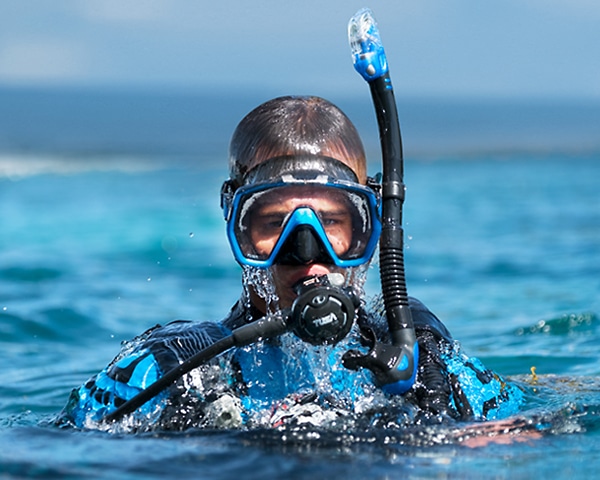The diving mask
Being able to see underwater well is the first requirement for diving. A well-fitting dive mask is an essential part of your dive equipment. Make sure you take the time to pick out a good mask at a professional shop or together with your IDD dive school.
Choosing a diving mask
There are several types of diving masks available. There are masks with a relatively small and large volume. The advantage of small volume masks is that they are easy to deflate and require less air to equalize the pressure inside the mask. The advantage of a "panoramic dive mask" is the large field of view it offers by choosing a mask with a large front glass or with additional side glass. The disadvantage of this type of diving mask is the large volume, which makes the mask slightly more difficult to deflate. Modern masks are made of rubber or silicone. A silicone mask is more flexible and durable than a rubber mask; it is also more resistant to sunlight, chlorine and salt water, does not cause skin irritation and is easier to clean and maintain.
What a good mask has to fulfil
A diving mask suitable for diving must meet the following requirements:
- The front glass and any side glass must be made of safety glass. You can recognize these glasses by the words Tempered or Safety on the glass.
- The edge of the diving mask, where the glass is attached, should be made of a solid material such as plastic or stainless steel.
- The strap of the mask should be made of strong rubber or silicon and should be able to be fixed by a simple and strong clamping mechanism. Furthermore, the strap of the mask should split in two parts at the back of the head to be able to attach it properly to the head.
- The diving mask should enclose the nose and be easily accessible from the outside for pinching.
In addition, a diving mask can be equipped with a waterless valve mounted on the bottom of the glass or on the nose clip. This valve helps to remove the water that has entered the mask. It is important that the water release valve has a large diameter, so that even large quantities of water can be blown out of the mask quickly and without effort.
Fitting a diving mask
After choosing a diving mask that at least meets the requirements, you must check whether the diving mask in question fits you properly and does not leak. You can check this by placing the diving mask without the headband against your face. After that you need to breathe in through your nose. A well-fitting dive mask will be sucked in against your face and stay in place as long as you hold your breath. If you can't keep the mask in place like this, the fit of your mask is not good enough and you need to try another mask.
Corrective lenses
There are, of course, divers who must use contact lenses or glasses above water. Under water divers can also use optically corrective lenses. There are diving masks of which the front lenses can be replaced by optically corrective lenses so you will have optimal vision under water. Nowadays you can also have special lenses mounted on the inside of your mask.
Mask Maintenance
- Make sure the glass is cleaned properly before your first dive. The IDD dive instructor can show you how to do this.
- For any dive use, you could make use of a remedy that won't fog up the glass.
- Make sure you are familiar with the mask strap so you can set it without thinking.
- After diving, rinse with fresh water and allow the mask to dry thoroughly.
- Do not let clear silicone come in contact with anything made of neoprene, such as black dive fins, because neoprene leaches the silicone and discolors it.

More diving equipment pieces
> To diving equipment >
